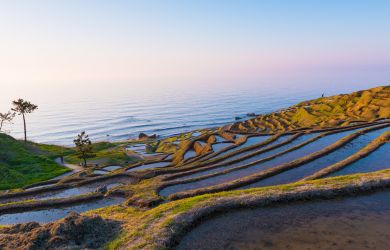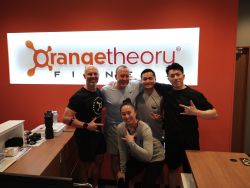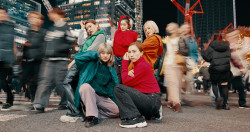
October 8, 2009
The Manga Cookbook
An innovative culinary guide drags otaku into the kitchen
By Metropolis
Originally published on metropolis.co.jp on October 2009

Photos courtesy of Japanime Co. Ltd
Japanese food and manga must be two of the country’s most successful exports, but they’re not the most obvious of bedfellows. However, an unorthodox cookbook is taking the world by storm by using comics to educate international readers in the world of Japanese cuisine.
“The Manga Cookbook is the world’s first, and only, English-language cookbook that uses step-by-step comic illustrations to teach young people how to make Japanese food,” says Glenn Kardy, founder of Japanime Co. Ltd. and its publishing imprint, Manga University. “We created it for every fan who’s ever wondered what the characters in their favorite Japanese comics are eating.”
The book is a collection of Japanese recipes introduced by a cast of original manga characters: Miyuki, her boyfriend Hiroshi, and their mascot cat-creature, Coo. It begins with a tutorial on chopsticks, continues with full-color photos of Japanese dishes, and teaches how to set a Japanese table before diving into a range of recipes for appetizers, bento boxed lunches, and main courses.
In keeping with Japanese tradition, much attention is paid to the overall presentation. The first few pages cover decorative tricks like converting an apple wedge into a rabbit or a wiener into octopus, followed by how to steam rice and make onigiri. More advanced recipes include yakitori, okonomiyaki, naruto (ham, cheese and seaweed) rolls, tamagoyaki (folded omelet) and even homemade udon noodles. Numerous pages are devoted to the multi-step production of decorative bento. Nutritionist and chef Yoko Ishihara dutifully notes the calories per serving, and offers helpful substitute ingredients for readers outside Japan.

By Kardy’s estimate, readers are as interested in Japan as they are in its cuisine. “We want to show these young people how they can lead a Japanese lifestyle,” he says. “So many manga have scenes with food that is exotic to foreigners. For instance, they’ll see a couple of characters eating bento boxed lunches, and then want to create bento themselves. Cooking and eating the same things as their favorite characters makes them feel closer to the story.”
While some of the recipes are a little vague on ingredients and none list the serving sizes, each is followed by notes on the place of food in Japanese culture and how these recipes are presented in manga. For example, onigiri evoke the mega-hit romance manga Fruits Basket, a story in which rice balls play a small part.
The Manga Cookbook took three years to complete, and is illustrated by Chihiro Hattori of the award-winning Manga de Kanji series. While the drawings are mostly just black-and-white line art, Hattori’s respect for the material comes through.
“Cooking isn’t just about taste, but also sight and smell,” she says. “I think that if people can summon an image of food then they can access deeper tastes. Manga is also not just about sight, but the act of summoning the senses. In this respect, manga is perhaps ideally suited for cooking.”

While Hattori views manga as the way to unlock taste and draw the reader in, Kardy sees making references to Japan in cooking as the best way to pique interest among young readers. With both of these elements together, it’s no surprise that The Young Adult Library Services Association chose The Manga Cookbook as one of their Quick Picks for Reluctant Young Readers.
The book has also topped Amazon’s list of best-selling Japanese cookbooks, shifting somewhere in the region of 20,000 copies to date. This year, it received an unexpected endorsement when La Cocotte, an upscale cookery boutique in Paris, began selling the text.
However, Kardy maintains that it’s the fans that make all his efforts worthwhile.
“They seem to love the book,” he says. “We’ve conducted cooking demonstrations at the past two Anime Expo conventions in Los Angeles, and both times the book was sold out by the end of the show.”
The Manga Cookbook, recipes by Yoko Ishihara, art by Chihiro Hattori (Japanime, 2007, 160pp, $14.95). Available via Amazon US and Amazon Japan
.







